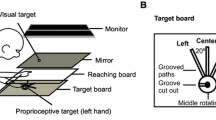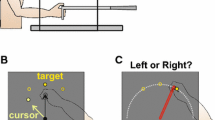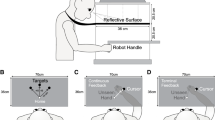Abstract
Many studies have shown that reaching movements to visual targets can rapidly adapt to altered visual feedback of hand motion (i.e., visuomotor rotation) and generalize to new target directions. This generalization is thought to reflect the acquisition of a neural representation of the novel visuomotor environment that is localized to the particular trained direction. In these studies, participants perform movements to a small number of target locations repeatedly. However, it is unclear whether adaptation and generalization are comparable when target locations are constantly varied and participants reach to visual targets one time only. Here, we compared performance for reaches to a 30° counter-clockwise visuomotor rotation to four targets, spaced 90° apart across four areas of workspace 18 times each (repeated practice (RP)) with one time only reaching movements to 72 targets, spaced 5° apart (varied practice (VP)). For both training groups, participants performed 18 reaches to radial targets (either at the repeated or varied location) in a specific area of the workspace (i.e., one of four quadrants) before reaching in the adjacent workspace. We found that the RP group adapted more completely compared to the VP group. Conversely, the VP group generalized to new target directions more completely when reaching without cursor feedback compared to the RP group. This suggests that RP and VP follow a mainly common pattern of adaptation and generalization represented in the brain, with benefits of faster adaptation with RP and more complete generalization with VP.



Similar content being viewed by others
References
Balitsky Thompson AK, Henriques DY (2010) Visuomotor adaptation and intermanual transfer under different viewing conditions. Exp Brain Res 202:543–552
Bays PM, Flanagan JR, Wolpert DM (2005) Interference between velocity-dependent and position-dependent force-fields indicates that tasks depending on different kinematic parameters compete for motor working memory. Exp Brain Res 163:400–405
Bock O (2003) Sensorimotor adaptation to visual distortions with different kinematic coupling. Exp Brain Res 151:557–560
Bock O, Schmitz G (2011) Adaptation to rotated visual feedback depends on the number and spread of target directions. Exp Brain Res 209:409–413
Caithness G, Osu R, Bays P, Chase H, Klassen J, Kawato M, Wolpert DM, Flanagan JR (2004) Failure to consolidate the consolidation theory of learning for sensorimotor adaptation tasks. J Neurosci 24:8662–8671
Cressman EK, Henriques DY (2009) Sensory recalibration of hand position following visuomotor adaptation. J Neurophysiol 102:3505–3518
Dionne JK, Henriques DY (2008) Interpreting ambiguous visual information in motor learning. J Vis 8(2):1–10
Ghahramani Z, Wolpert DM, Jordan MI (1996) Generalization to local remappings of the visuomotor coordinate transformation. J Neurosci 16:7085–7096
Ghez C, Scheidt R, Heijink H (2007) Different learned coordinate frames for planning trajectories and final positions in reaching. J Neurophysiol 98:3614–3626
Ghilardi MF, Gordon J, Ghez C (1995) Learning a visuomotor transformation in a local area of work space produces directional biases in other areas. J Neurophysiol 73:2535–2539
Imamizu H, Uno Y, Kawato M (1995) Internal representations of the motor apparatus: implications from generalization in visuomotor learning. J Exp Psychol Hum Percept Perform 21:1174–1198
Kagerer FA, Contreras-Vidal JL (2009) Adaptation of sound localization induced by rotated visual feedback in reaching movements. Exp Brain Res 193:315–321
Klassen J, Tong C, Flanagan JR (2005) Learning and recall of incremental kinematic and dynamic sensorimotor transformations. Exp Brain Res 164:250–259
Krakauer JW, Ghilardi MF, Ghez C (1999) Independent learning of internal models for kinematic and dynamic control of reaching. Nat Neurosci 2:1026–1031
Krakauer JW, Pine ZM, Ghilardi MF, Ghez C (2000) Learning of visuomotor transformations for vectorial planning of reaching trajectories. J Neurosci 20:8916–8924
Mattar AA, Ostry DJ (2007) Modifiability of generalization in dynamics learning. J Neurophysiol 98:3321–3329
Overduin SA, Richardson AG, Lane CE, Bizzi E, Press DZ (2006) Intermittent practice facilitates stable motor memories. J Neurosci 26:11888–11892
Pine ZM, Krakauer JW, Gordon J, Ghez C (1996) Learning of scaling factors and reference axes for reaching movements. NeuroReport 7:2357–2361
Shadmehr R, Brashers-Krug T (1997) Functional stages in the formation of human long-term motor memory. J Neurosci 17:409–419
Tanaka H, Sejnowski TJ, Krakauer JW (2009) Adaptation to visuomotor rotation through interaction between posterior parietal and motor cortical areas. J Neurophysiol 102:2921–2932
Vetter P, Goodbody SJ, Wolpert DM (1999) Evidence for an eye-centered spherical representation of the visuomotor map. J Neurophysiol 81:935–939
Wang J, Sainburg RL (2005) Adaptation to visuomotor rotations remaps movement vectors, not final positions. J Neurosci 25:4024–4030
Woolley DG, Tresilian JR, Carson RG, Riek S (2007) Dual adaptation to two opposing visuomotor rotations when each is associated with different regions of workspace. Exp Brain Res 179:155–165
Acknowledgments
The authors would like to thank Mark Gianforcaro, Yulia Metersky, and Milad Modabber for help with data collection. This research was supported by the Banting Foundation and the Canadian Institutes of Health Research (CIHR). DYPH is an Alfred Sloan Fellow.
Author information
Authors and Affiliations
Corresponding author
Rights and permissions
About this article
Cite this article
Neva, J.L., Henriques, D.Y.P. Visuomotor adaptation and generalization with repeated and varied training. Exp Brain Res 226, 363–372 (2013). https://doi.org/10.1007/s00221-013-3444-1
Received:
Accepted:
Published:
Issue Date:
DOI: https://doi.org/10.1007/s00221-013-3444-1




